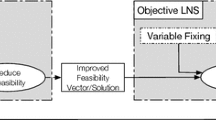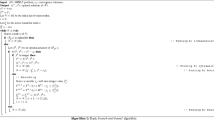Abstract
The recent development in inverse optimization, in particular the extension from the inverse linear programming problem to the inverse mixed integer linear programming problem (InvMILP), provides more powerful modeling tools but also presents more challenges to the design of efficient solution techniques. The only reported InvMILP algorithm, referred to as AlgInvMILP, although finitely converging to global optimality, suffers two limitations that greatly restrict its applicability: it is time consuming and does not generate a feasible solution except for the optimal one. This paper presents heuristic algorithms that are designed to be implemented and executed in parallel with AlgInvMILP in order to alleviate and overcome its two limitations. Computational experiments show that implementing the heuristic algorithm on one auxiliary processor in parallel with AlgInvMILP on the main processor significantly improves its computational efficiency, in addition to providing a series of improving feasible upper bound solutions. The additional speedup of parallel implementation on two or more auxiliary processors appears to be incremental, but the upper bound can be improved much faster.
Similar content being viewed by others
References
Achterberg T., Koch T., Martin A.: MIPLIB 2003. Oper. Res. Lett. 34, 361–372 (2006)
Ahuja R.K., Orlin J.B.: Inverse optimization. Oper. Res. 49, 771–783 (2001)
Awerbuch S.: Portfolio-based electricity generation planning: policy implications for renewables and energy security. Mitigation Adapt. Strategies Global Change 11, 693–710 (2006)
Beil D.R., Wein L.M.: An inverse-optimization-based auction mechanism to support a multiattribute RFQ process. Manage. Sci. 49, 1529–1545 (2003)
Bitran G.R., Chandru V., Sempolinski D.E., Shapiro J.F.: Inverse optimization: an application to the capacitated plant location problem. Manage. Sci. 27, 1120–1141 (1981)
Burton D., Toint P.L.: On an instance of the inverse shortest paths problem. Math. Program. 53, 45–61 (1992)
Cai M.C., Yang X.G., Zhang J.Z.: The complexity analysis of the inverse center location problem. J. Global Optim. 15, 213–218 (1999)
Dial R.B.: Minimal-revenue congestion pricing part I: a fast algorithm for the single-origin case. Transp. Res. B 33, 189–202 (1999)
Dial R.B.: Minimal-revenue congestion pricing part II: an efficient algorithm for the general case. Transp. Res. B 34, 645–665 (2000)
Faragó A., Szentesi Á., Szviatovszki B.: Inverse optimization in high-speed networks. Discrete Appl. Math. 129, 83–98 (2003)
Heuberger C.: Inverse combinatorial optimization: a survey on problems, methods, and results. J. Comb. Optim. 8, 329–361 (2004)
Hurkmans C.W., Meijer G.J., van Vliet-Vroegindeweij C., van der Sangen M.J., Cassee J.: High-dose simultaneously integrated breast boost using intensity-modulated radiotherapy and inverse optimization. Int. J. Radiat. Oncol. Biol. Phys. 66, 923–930 (2006)
Kim H., Rho O.: Dual-point design of transonic airfoils using the hybrid inverse optimization method. J. Aircraft 34, 612–618 (1997)
Menke W.: Geophysical Data Analysis: Discrete Inverse Theory. Academic Press, San Diego (1989)
Moser T.J.: Shortest paths calculation of seismic rays. Geophysics 56, 59–67 (1991)
Tarantola A.: Inverse Problem Theory: Methods for Data Fitting and Model Parameter Estimation. Elsevier, Amsterdam (1987)
Wang L., Mazumdar M.: Using a system model to decompose the effects of influential factors on locational marginal prices. IEEE Trans. Power Syst. 22, 1456–1465 (2007)
Wang L.: Cutting plane algorithms for the inverse mixed integer linear programming problem. Oper. Res. Lett. 37, 114–117 (2009)
Yang C., Zhang J.: Two general methods for inverse optimization problems. Appl. Math. Lett. 12, 69–72 (1999)
Zhang B., Zhang J., He Y.: Constrained inverse minimum spanning tree problems under the bottleneck-type Hamming distance. J. Global Optim. 34, 467–474 (2006)
Zhang J., Ma Z., Yang C.: A column generation method for inverse shortest path problems. Math. Methods Oper. Res. 41, 347–358 (1995)
Author information
Authors and Affiliations
Corresponding author
Rights and permissions
About this article
Cite this article
Duan, Z., Wang, L. Heuristic algorithms for the inverse mixed integer linear programming problem. J Glob Optim 51, 463–471 (2011). https://doi.org/10.1007/s10898-010-9637-2
Received:
Accepted:
Published:
Issue Date:
DOI: https://doi.org/10.1007/s10898-010-9637-2




